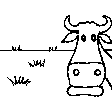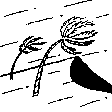



Push–pull technology was developed by the International Centre of Insect Physiology and Ecology (ICIPE) in collaboration with Rothamsted Research, (UK) in Kenya in the 1990s for the control of stemborer and striga weed in resource-poor maize farming systems. It is a strategy for controlling pests by using plants that repel them i.e., “push” crops and plants that trap pests i.e., “pull” crops. In Kakamega, Siaya, and Bungoma counties of western Kenya (i.e., the ProSoil project areas), the production of maize, millet, and sorghum has greatly been affected by poor soil fertility; insect pests, especially stemborer; and a parasitic weed called striga. Under the ProSoil project, Desmodium intortum is the main repellent “push” crop while napier grass (Pennisetum purpureum), brachiaria (Brachiaria decumbens), and mulatto (Brachiaria ruziziensis) are the main “pull” or trap plants.
In a typical push-pull system, the attractant “pull” plant is planted as a border around the field where the main crop e.g., maize, millet, or sorghum has been intercropped with the “push” crop. Desmodium produces repellent volatile chemicals that push away stemborer moths from the main field towards the edge where there is the “pull” or trap crop. The attractant trap plant emits volatile compounds which serve as a haven for the stemborers. As the stemborer moths lay eggs on the pull/ trap plant (in this case bracharia) and the eggs hatch and develop into larvae or caterpillar stage, a sticky substance like glue secreted by the bracharia physically traps the larvae; hence, inhibiting further development. In addition, desmodium stimulates the germination of striga and then effectively inhibits its growth through its roots' exudates.
“Push-pull” technology improves the productivity of cereal crops, controls soil erosion, and contributes to conservation agriculture (minimum tillage). Desmodium and bracharia are both high-quality animal fodder plants and because of their perennial nature, they maintain ground cover. Bracharia is rich in crude protein. Desmodium is a leguminous green manure cover crop and, therefore, it fixes nitrogen in the soil and improves soil organic matter. Desmodium does not suppress the main crop since it is not a climber.
One acre (0.4 ha) of land (in a push-pull system) requires about 0.75 kg of desmodium seeds and about 0.5 kg of brachiaria seeds. Desmodium is planted at a spacing of 75 cm between rows and 60 cm between plants in the same row. The cereal crop is established in rows parallel to the desmodium crop rows (e.g., 75 cm from row to row and 30 cm from plant to plant in the same row for maize). Brachiaria is planted in two shallow trenches (50 cm apart) and because the seeds are very tiny, they are sown on the surface of the trenches and covered with a very thin layer of soil to keep them in place, in darkness, until they sprout. They are later thinned to give a spacing of 25 cm between plants.

ສະຖານທີ່: Khalaba Ward, Matungu Sub-county, in Kakamega County, Kakamega County in western Kenya, ເຄັນຢາ
ຈໍານວນ ພື້ນທີ່ ທີ່ໃຊ້ ເຕັກໂນໂລຢີ ທີ່ໄດ້ວິເຄາະ: 2-10 ພຶ້ນທີ່
ການແຜ່ກະຈາຍຂອງເຕັກໂນໂລຢີ: ແຜ່ຂະຫຍາຍຢ່າງໄວວາໃນພື້ນທີ່ (approx. < 0.1 ກິໂລແມັດ2 (10 ເຮັກຕາ))
ຢູ່ໃນເຂດປ່າສະຫງວນທີ່ບໍ?: ບໍ່ແມ່ນ
ວັນທີຂອງການປະຕິບັດ: 2019
ປະເພດຂອງການນໍາສະເໜີ



| ສາຍພັນ | ນັບ |
| ສັດໃຫ່ຍ-ງົວພັນນົມ | 3 |
| ສັດປີກ | 55 |
| ແບ້ | 4 |





| ລະບຸ ປັດໃຈ ນໍາເຂົ້າ ໃນການຜະລີດ | ຫົວໜ່ວຍ | ປະລິມານ | ຕົ້ນທຶນ ຕໍ່ຫົວໜ່ວຍ (KES) | ຕົ້ນທຶນທັງໝົດ ຂອງປັດໃຈຂາເຂົ້າ ໃນການຜະລິດ (KES) | % ຂອງຕົ້ນທຶນທັງໝົດ ທີ່ຜູ້ນໍາໃຊ້ທີ່ດິນ ໃຊ້ຈ່າຍເອງ |
| ແຮງງານ | |||||
| Land preparation | Man-days | 4.0 | 250.0 | 1000.0 | 100.0 |
| ອຸປະກອນ | |||||
| Slasher | No. | 1.0 | 70.0 | 70.0 | |
| African machete (panga) | No. | 1.0 | 80.0 | 80.0 | |
| Jab planter | No. | 1.0 | 1000.0 | 1000.0 | |
| ວັດສະດຸໃນການປູກ | |||||
| Bracharia seeds | Kgs | 0.1 | 420.0 | 42.0 | |
| Desmodium seeds | Kgs | 0.26 | 420.0 | 109.2 | |
| Maize seeds | Kgs | 1.0 | 180.0 | 180.0 | 100.0 |
| ຝຸ່ນ ແລະ ຢາຊີວະພາບ | |||||
| Manure | Wheelbarrows | 30.0 | 70.0 | 2100.0 | |
| ຕົ້ນທຶນທັງໝົດ ໃນການຈັດຕັ້ງປະຕິບັດ ເຕັກໂນໂລຢີ | 4'581.2 | ||||
| ຄ່າໃຊ້ຈ່າຍທັງໝົດ ສຳລັບການສ້າງຕັ້ງເຕັກໂນໂລຢີ ເປັນສະກຸນເງີນໂດລາ | 36.88 | ||||
| ລະບຸ ປັດໃຈ ນໍາເຂົ້າ ໃນການຜະລີດ | ຫົວໜ່ວຍ | ປະລິມານ | ຕົ້ນທຶນ ຕໍ່ຫົວໜ່ວຍ (KES) | ຕົ້ນທຶນທັງໝົດ ຂອງປັດໃຈຂາເຂົ້າ ໃນການຜະລິດ (KES) | % ຂອງຕົ້ນທຶນທັງໝົດ ທີ່ຜູ້ນໍາໃຊ້ທີ່ດິນ ໃຊ້ຈ່າຍເອງ |
| ແຮງງານ | |||||
| Shallow weeding | Man-days | 2.0 | 250.0 | 500.0 | |
| Root management | Man-days | 2.0 | 250.0 | 500.0 | |
| Ripping | Man-days | 4.0 | 250.0 | 1000.0 | |
| ອຸປະກອນ | |||||
| Shallow weeder | No. | 1.0 | 80.0 | 80.0 | |
| Chaka hoe | No. | 1.0 | 130.0 | 130.0 | |
| African machete (panga) | No. | 1.0 | 80.0 | 80.0 | |
| ຕົ້ນທຶນທັງໝົດ ທີ່ໃຊ້ໃນການບໍາລຸງຮັກສາ ເຕັກໂນໂລຢີ | 2'290.0 | ||||
| ຄ່າໃຊ້ຈ່າຍທັງໝົດ ສຳລັບການບົວລະບັດຮກສາເຕັກໂນໂລຢີ ເປັນສະກຸນເງີນໂດລາ | 18.44 | ||||
The above rating varies from one village to the other.
ປະລິມານ ກ່ອນການຈັດຕັ້ງປະຕິບັດ ການຄຸ້ມຄອງ ທີ່ດິນແບບຍືນຍົງ: 2
ປະລີມານ ຫຼັງການຈັດຕັ້ງປະຕິບັດ ການຄຸ້ມຄອງ ທີ່ດິນແບບຍືນຍົງ: 5
Quantity refers to the number of 90 Kg bags of maize produced per acre. Based on the farmer's experience.
Not easy to quantify. The crops do better compared to the past. Based on the farmer's estimate.
ປະລິມານ ກ່ອນການຈັດຕັ້ງປະຕິບັດ ການຄຸ້ມຄອງ ທີ່ດິນແບບຍືນຍົງ: 0
ປະລີມານ ຫຼັງການຈັດຕັ້ງປະຕິບັດ ການຄຸ້ມຄອງ ທີ່ດິນແບບຍືນຍົງ: 10
Quantity refers to amount of bracharia and desmodium in tonnes per year. Based on the farmer's estimate.
Not easy to quantify. Fodder does better compared to how it was before the technology. Based on the farmer's estimate.
ປະລິມານ ກ່ອນການຈັດຕັ້ງປະຕິບັດ ການຄຸ້ມຄອງ ທີ່ດິນແບບຍືນຍົງ: 2
ປະລີມານ ຫຼັງການຈັດຕັ້ງປະຕິບັດ ການຄຸ້ມຄອງ ທີ່ດິນແບບຍືນຍົງ: 8
Quantity refers to the amount of milk in litres from one cow. Based on the farmer's estimate.
ປະລິມານ ກ່ອນການຈັດຕັ້ງປະຕິບັດ ການຄຸ້ມຄອງ ທີ່ດິນແບບຍືນຍົງ: 70
ປະລີມານ ຫຼັງການຈັດຕັ້ງປະຕິບັດ ການຄຸ້ມຄອງ ທີ່ດິນແບບຍືນຍົງ: 30
Quantity refers to the percentage probability of the crop failing to do well. Based on the farmer's estimate.
Not easy to quantify but it is easier to prepare land through no tillage than to plough. Based on the farmer's estimate.
ປະລິມານ ກ່ອນການຈັດຕັ້ງປະຕິບັດ ການຄຸ້ມຄອງ ທີ່ດິນແບບຍືນຍົງ: 7,000
ປະລີມານ ຫຼັງການຈັດຕັ້ງປະຕິບັດ ການຄຸ້ມຄອງ ທີ່ດິນແບບຍືນຍົງ: 0
Quantity refers to the amount of money in Kenya shillings spend on inorganic fertilizers in a season. The farmer no longer buys money inorganic fertilizers.
ປະລິມານ ກ່ອນການຈັດຕັ້ງປະຕິບັດ ການຄຸ້ມຄອງ ທີ່ດິນແບບຍືນຍົງ: 1,000
ປະລີມານ ຫຼັງການຈັດຕັ້ງປະຕິບັດ ການຄຸ້ມຄອງ ທີ່ດິນແບບຍືນຍົງ: 15,000
Quantity refers to amount of money from farming per year.
ປະລິມານ ກ່ອນການຈັດຕັ້ງປະຕິບັດ ການຄຸ້ມຄອງ ທີ່ດິນແບບຍືນຍົງ: 2
ປະລີມານ ຫຼັງການຈັດຕັ້ງປະຕິບັດ ການຄຸ້ມຄອງ ທີ່ດິນແບບຍືນຍົງ: 4
Quantity refers to the number of household income sources. Based on the farmer's estimate.
Not easy to quantify but it is easier to prepare land through no tillage than to plough. Based on the farmer's estimate.
ປະລິມານ ກ່ອນການຈັດຕັ້ງປະຕິບັດ ການຄຸ້ມຄອງ ທີ່ດິນແບບຍືນຍົງ: 20
ປະລີມານ ຫຼັງການຈັດຕັ້ງປະຕິບັດ ການຄຸ້ມຄອງ ທີ່ດິນແບບຍືນຍົງ: 80
Quantity refers to the estimated percentage of knowledge in SLM/ land management. Based on the farmer's estimate. He says his SLM knowledge has greatly increased.
Not easy for the farmer to quantify. Based on the farmer's estimate. Soil erosion has been controlled to some considerable degree at the farm.
Not easy for the farmer to quantify. Based on the farmer's estimate.
Not easy for the farmer to quantify. The number of plants at the farm has increased.
Not easy for the farmer to quantify.